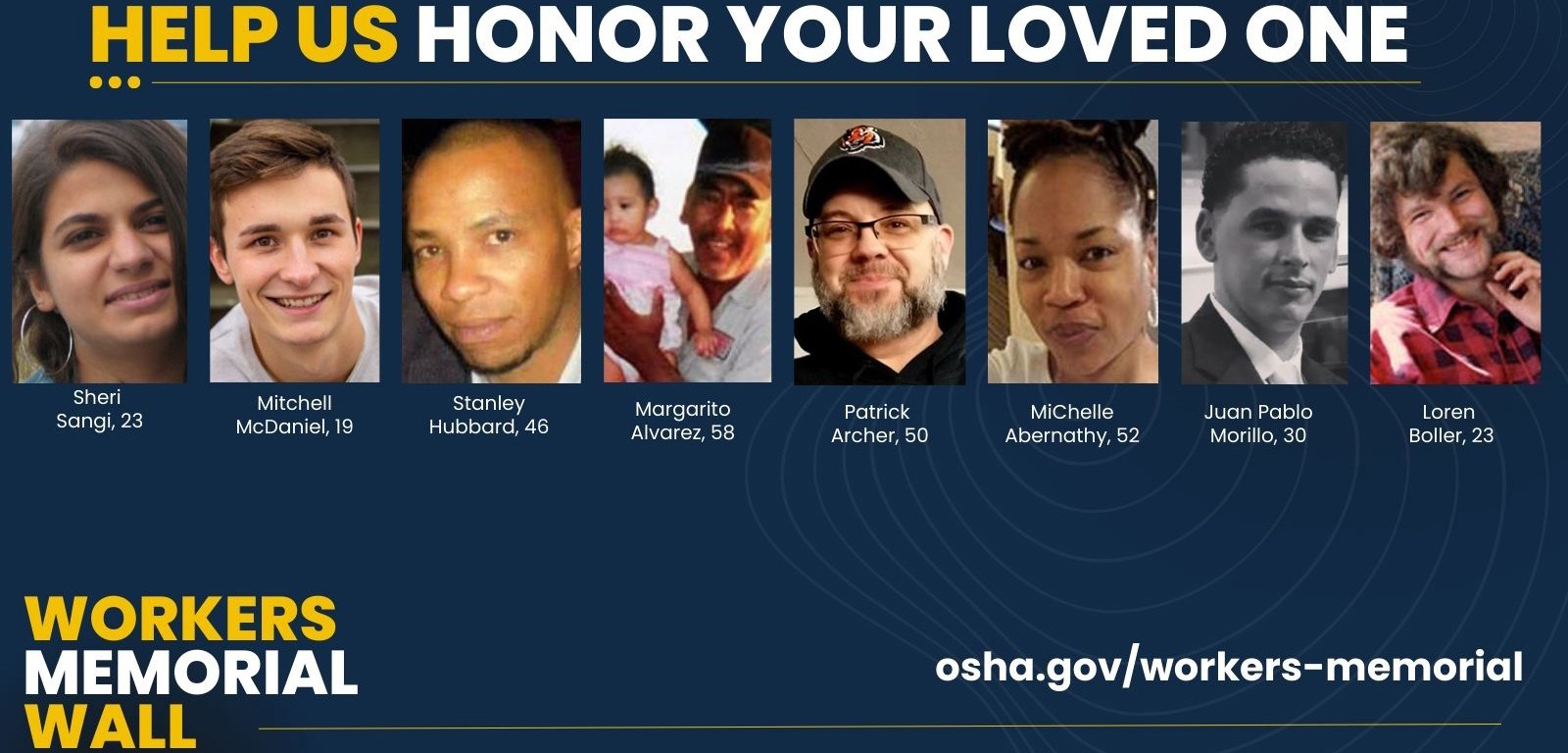Today is Workers Memorial Day, a day dedicated — in labor organizer Mother Jones’ words — to mourn for the dead and fight like hell for the living.
In addition to the many events held nationwide, the Department of Labor held a moving ceremony today in Washington D.C. today. (Hopefully, a video of the event will appear soon). Today’s event, headlined by Acting Secretary of Labor Julie Su, MSHA and OSHA heads Chris Williamson and Doug Parker, AFL-CIO President Liz Schuler and families of workers killed on the job, moved the workplace safety discussion from the statistics to the people, from the data to the tears.
The event was organized by OSHA’s new Family Liaison, Tonya Ford. Some of you may know Tonya as the former director of the United Support & Memorial for Workplace Fatalities, an organization that strives to honor, remember and recognize workers killed on the job and support their families.
Tonya has been a leader in occupational safety and health since her uncle Bobby was killed in a grain elevator in 2009.
And President Joe Biden also issued a Workers Memorial Day statement, reminding the nation that
A safe and healthy workplace is fundamental. In the United States of America, no one should have to risk their lives just to make a living. Today, we honor those workers who put it all on the line, and we keep their families in our hearts. We celebrate the whistleblowers and union organizers whose courage and persistence has saved countless lives, and we join them in standing up for all American workers, who are the best in the world.
Workers Memorial Day is scheduled every year on the anniversary of the creation of the Occupational Safety and Health Administration. But April is also infamous as a month of some of the most tragic workplace disasters in recent history.
I’m republishing below a piece I wrote last year at this time about the tragedies of April. I always have mixed feelings when I publicize these events. On one hand, horrific disasters where multiple workers are killed tend to focus the attention of the American public — and often lead to change.
But by focusing only on these events, we tend to overlook the daily tragedies that kill over 400 workers every month. Most die alone, memorialized only be a short article in the local paper, and remembered only by their families, friends and co-workers.
April: The Month of Workplace Disasters
April 28 is Workers Memorial Day — a day dedicated to memorializing those killed on the job and rededicating ourselves to fighting for the living. April 28 was picked because it’s the anniversary of the Occupational Safety and Health Administration. And coincidentally, April is an especially tragic time to remember some of the most serious workplace tragedies in American — and world — history.
Upper Big Branch Mine Disaster, Raleigh County, WV, April 5, 2010: An explosion at the Upper Big Branch mine killed 29 miners. The Mine Safety and Health Administration concluded that flagrant safety violations contributed to the explosion. It issued 369 citations at that time, assessing $10.8 million in penalties
Ammonium Nitrate Explosion, Texas City, TX, April 16, 1947: A fire on the French-registered vessel SS Grandcamp detonated her cargo of about 2,300 tons of ammonium nitrate. This started a chain reaction of fires and explosions in other ships and nearby oil-storage facilities, ultimately killing at least 581 people, including all but one member of the Texas City fire department. It was the deadliest industrial accident in U.S. history and one of history’s largest non-nuclear explosions.
West Fertilizer Explosion, West, TX, April 17, 2013: An ammonium nitrate explosion occurred at the West Fertilizer Company storage and distribution facility in West, Texas. Fifteen people were killed, including 12 firefighters and emergency responders, more than 160 were injured, and more than 150 buildings were damaged or destroyed.
Deepwater Horizon Explosion, April 20, 2012: A fire and explosion on the Deepwater Horizon drilling rig killed 11 workers and resulted in the largest marine oil spill and environmental disaster in history.
L’Ambiance Plaza Collapse, Bridgeport, CT, April 23, 1987: The L’Ambiance Plaza apartment building collapsed due to a faulty lift slab construction technique while under construction, killing 28 construction workers.
Rana Plaza Factor Collapse, Bangladesh, April 24, 2013: The eight-story Rana Plaza factory building collapsed, killing 1134 people. The shops and the bank on the lower floors were immediately closed after cracks were discovered in the building the day before the collapse. But the building’s owners ignored warnings ordering garment workers to return the following day and the building collapsed during the morning rush-hour.
Chernobyl Nuclear Power Plant Disaster, Ukraine, USSR April 26, 1986: No. 4 reactor in the Chernobyl Nuclear Power Plant exploded during a safety test It was the worst nuclear disaster in history. Dozens of operators and response workers died due to massive radiation exposure and hundreds more from the nuclear fallout.
Willow Island Collapse, Willow Island, WV, April 27, 1978: A cooling tower under construction at the Pleasants Power Station at Willow Island, West Virginia, collapsed, killing 51 construction workers. It was the deadliest construction accident in U.S. history
Originally published April 20, 2022
Related
Workers Memorial Day 2023 — A Time for Reflection and a Call to Action
